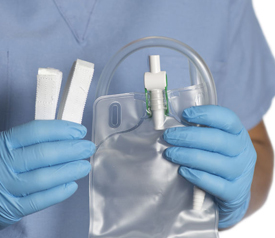
What is a nephrostomy tube?
The simplest way to describe a nephrostomy tube is that it is a catheter, or a thin plastic tube that travels through the back and into the kidney. Patients may have one tube or two tubes (one in each kidney). It continuously drains urine directly from the kidney into a bag that is generally attached to your leg.
Normally, a healthy kidney will process liquid and create urine which drains through the ureter into the bladder. In some cases, an obstruction occurs (kidney stone, an infection, congenital malformation, an accident, or swelling after surgery) and ruin can not reach the bladder to be eliminated. When this happens, a specialist called an interventional radiologist uses image guidance to insert the catheter into the body. It may be done under general anesthesia or with conscious sedation and generally takes less than an hour.
A nephrostomy tube is a temporary device and generally is employed for a few days, weeks or in extreme cases months. In cases when extended periods of time, a new tube may need to be inserted.
Caring for a nephrostomy tube & dressing
Because of the location, you will need assistance cleaning and caring for the insertion site. A nurse will point out a mark on the catheter tube. This mark should always be the same distance from the disc that covers the site. If it moves, them means the catheter needs attention and you should consult your care professional.
Securing the bag to your leg is very important. It will ensure that the catheter does not pull and the urine flows continuously. A kinked or bent catheter line can pose a problem.
There are instances where blood appears in your urine shortly after the procedure. It is important to inspect the color of your urine frequently. If you have bad smelling, cloudy, or blood laced urine call your care professional.
Inspecting the catheter and dressing can prevent infection or irritation. If the dressing becomes wet, is soiled, or comes loose it should be changed.
It is also important look at your skin surrounding the catheter when changing the dressing. If the area is red, bleeding, or presents a rash due to a leak or a reaction to an adhesive, you should consult your care professional immediately.
It is very important to contact your nurse or doctor if the catheter slips. If the clamp around the disc loosens or opens. If you develop a fever or get chills. If you have pain, swelling, or irritation around the catheter site. If the tube becomes clogged or the flow of urine is impeded or is much less than normal.
Securing your nephrostomy catheter and dressing with latex free Hy-Tape
Hy-Tape is a good choice for securing a nephostomy catheter and waterproofing the dressing. Hy-Tape is thin and conforming, which makes it perfect for securing tubes and devices. Hy-Tapes flexibility allows for movement and tissue shifts reducing the chances for skin injuries. Hy-Tape is also the preferred waterproof tape for keeping dressings dry. Patients can rest assured that when Hy-Tape is applied to clean, dry, lotion free skin, showering can be accomplished without compromising the dressing. Less dressing changes result is faster healing, less irritation, and a better quality of life. The zinc-oxide that is infused into Hy-Tapes gentle, yet strong adhesive helps sooth skin that may be subject to repeat tape applications.
Learn more bout how Hy-Tape secures tubes and devices without compromising skin.
- Tube Securement for Preemies & Babies
- Securing and Waterproofing Your Child’s Feeding Tube
- Preventing Skin Injuries When Securing Endotracheal Tube
- PICC Lines – Waterproofing, Securement, Skin Reactions
- Securing Gastrostomy Tubes & Tape Sensitivity
- Insulin Pump Securement: Infusion Set Taping Tips
- Nasal Cannula Securement for Seniors, Infants, Toddlers, & Small Children

